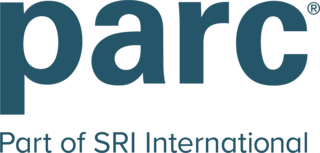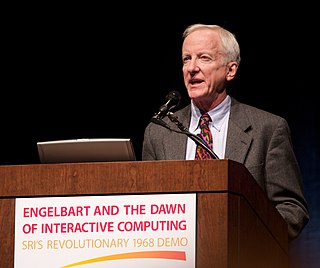Related Research Articles

Sun Microsystems, Inc., often known as Sun for short, was an American technology company that existed from 1982 to 2010 which developed and sold computers, computer components, software, and information technology services. Sun contributed significantly to the evolution of several key computing technologies, among them Unix, RISC processors, thin client computing, and virtualized computing. At its height, the Sun headquarters were in Santa Clara, California, on the former west campus of the Agnews Developmental Center.

SRI Future Concepts Division is a research and development company in Palo Alto, California. It was founded in 1969 by Jacob E. "Jack" Goldman, chief scientist of Xerox Corporation, as a division of Xerox, tasked with creating computer technology-related products and hardware systems.

James Arthur Gosling is a Canadian computer scientist, best known as the founder and lead designer behind the Java programming language.

Johns Frederick (Jeff) Rulifson is an American computer scientist.

Guy Lewis Steele Jr. is an American computer scientist who has played an important role in designing and documenting several computer programming languages and technical standards.
WATFIV, developed at the University of Waterloo, Canada is an implementation of the Fortran computer programming language. It is the successor of WATFOR.

Daniel Henry Holmes Ingalls Jr. is a pioneer of object-oriented computer programming and the principal architect, designer and implementer of five generations of Smalltalk environments. He designed the bytecoded virtual machine that made Smalltalk practical in 1976. He also invented bit blit, the general-purpose graphical operation that underlies most bitmap computer graphics systems today, and pop-up menus. He designed the generalizations of BitBlt to arbitrary color depth, with built-in scaling, rotation, and anti-aliasing. He made major contributions to the Squeak version of Smalltalk, including the original concept of a Smalltalk written in itself and made portable and efficient by a Smalltalk-to-C translator.
Fortress is a discontinued experimental programming language for high-performance computing, created by Sun Microsystems with funding from DARPA's High Productivity Computing Systems project. One of the language designers was Guy L. Steele Jr., whose previous work includes Scheme, Common Lisp, and Java.

The Department of Computer Science is one of nine departments in the University of the Philippines Diliman College of Engineering.

Robert Fletcher "Bob" Sproull is an American computer scientist, who worked for Oracle Corporation where he was director of Oracle Labs in Burlington, Massachusetts. He is currently an adjunct professor at the College of Information and Computer Sciences, at the University of Massachusetts Amherst.
Richard P. Gabriel is an American computer scientist known for his work in computing related to the programming language Lisp, and especially Common Lisp. His best known work was a 1990 essay "Lisp: Good News, Bad News, How to Win Big", which introduced the phrase Worse is Better, and his set of benchmarks for Lisp, termed Gabriel Benchmarks, published in 1985 as Performance and evaluation of Lisp systems. These became a standard way to benchmark Lisp implementations.
The David R. Cheriton School of Computer Science is a professional school within the Faculty of Mathematics at the University of Waterloo. QS World University Rankings ranked the David R. Cheriton School of Computer Science 21st in the world, 10th in North America and 2nd in Canada in Computer Science in 2024. U.S. News & World Report ranked the David R. Cheriton School of Computer Science 42nd in world and second in Canada.

Java is a set of computer software and specifications that provides a software platform for developing application software and deploying it in a cross-platform computing environment. Java is used in a wide variety of computing platforms from embedded devices and mobile phones to enterprise servers and supercomputers. Java applets, which are less common than standalone Java applications, were commonly run in secure, sandboxed environments to provide many features of native applications through being embedded in HTML pages.

James Wesley Graham, OC was a Canadian professor of computer science at the University of Waterloo.
WATIAC was a virtual computer developed for teaching the principles of assembly language programming to undergraduates. WATIAC, and the WATMAP assembly language that ran on it were developed in 1973 by the newly founded Computer Systems Group, at the University of Waterloo, under the direction of Wes Graham.
WATBOL is a teaching compiler for the COBOL programming language developed in 1969 at the University of Waterloo. The compiler was a companion product, built under the design philosophy, of Waterloo's earlier, widely used WATFOR teaching compiler. Since programs written by undergraduate students were unlikely to be run more than a few times, after they were successfully written and debugged, the efficiency of the program, once compiled was of secondary importance, compared with giving simpler, clearer error messages, and in simplifying the steps for the student to compile the program. At that time executing a program through the use of commercial compiler was a three-step process. First the Fortran, or COBOL, had to be compiled into assembly language, then the assembly language had to be assembled into binary code; finally the compiled and assembled code had to be linked with previously written libraries of subroutines. WATFOR and WATBOL allowed simple programs to be compiled, linked, and executed in a single step.
Franklin David Boswell is a Canadian computer scientist who was awarded the J.W. Graham Medal for his contributions to the field in 2003.

Kenneth ("Ken") Arthur Robinson was an Australian computer scientist. He has been called "The Father of Formal Methods in Australia".
References
- ↑ "James Mitchell". The People at Oracle Labs. Oracle Corporation. Archived from the original on June 16, 2012. Retrieved April 1, 2011.
- ↑ Schick, Shane (2007-04-09). "U of Waterloo alumni look back on creator of Fortran variant: Wes Graham was critical to the development of popular WATFOR". IT Business. Archived from the original on 2012-03-08. Retrieved 2012-12-17.
Mitchell, now a Sun Fellow at Sun Microsystems, wrote a student paper in 1965 about building a fast compiler. That's when he was called into Graham's office. "The teacher from the program was there, and the paper was on Graham's desk," Mitchell said. "He said, 'So, do you think you could really do this?' And I said 'Yes, with some extremely good programmers."'
- ↑ "Computer innovator to visit". news release. University of Waterloo. May 26, 1997. Retrieved April 3, 2011.
- ↑ Mitchell, James George (1970). The design and construction of flexible and efficient interactive programming systems (PhD). USA: Carnegie Mellon University.
- ↑ "Dr. James Mitchell". Shurl and Kay Curci Foundation. Torrance, California.
- ↑ "Java: Where You Want to *Be* Tomorrow: Dr. Jim Mitchell, 1997 Recipient of the J.W. Graham Medal in Computing and Innovation". University of Waterloo, Canada. May 30, 1997. Archived from the original on July 6, 2011. Retrieved April 1, 2011.
- ↑ "Recipients of the J.W. Graham Medal in Computing & Innovation". University of Waterloo . Retrieved 2015-09-25.